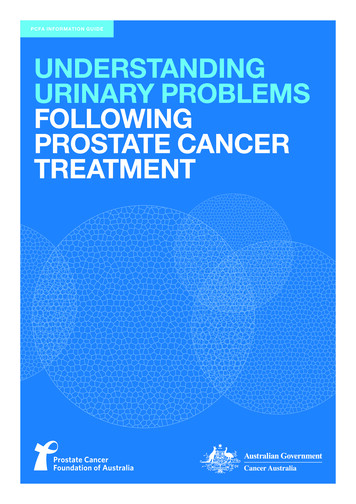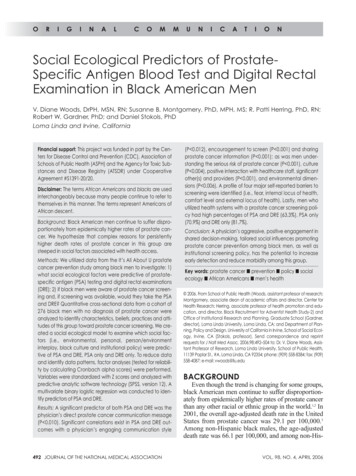
Transcription
FAQ About ProstateCancer Treatmentand SpaceOAR SystemP. 4
SpaceOAR Frequently Asked Questions (FAQ)Prostate Cancer Background1. What is prostate cancer?The vast majority of prostate cancers develop in the prostate gland of the male reproductivesystem. Most prostate cancers occur in men over the age of 50,1 and more than 80 percent arefound in the early stages when cancer cells are confined to the prostate.2 Prostate tumors mostoften occur in the lower part of the prostate, known as the peripheral zone,3 or the area closestto the rectal wall. Prostate cancer is detected by the prostate-specific antigen (PSA) test of thepatient’s blood, by a digital rectal exam and a prostate biopsy.2. What is the prevalence of prostate cancer?According to the American Cancer Society (ACS), prostate cancer is the second-most-commoncancer in American men and the second-leading cause of cancer-related death in the U.S. ACSestimates that more than 220,000 new cases of prostate cancer will be diagnosed in 2015 andmore than 27,500 men will die from the disease this year.4 Worldwide prostate cancer incidenceand mortality are expected to grow to 1.7 million new cases per year and 499,000 new deathsby the year 2030.53. What are the treatment options for prostate cancer patients?There are several treatment options for early-stage prostate cancer patients, including surgery,radiation therapy, watchful waiting and active surveillance.6 Surgery (or prostatectomy) involvesremoving the prostate gland and surrounding tissue and can be performed as open, robotic orlaparoscopic surgery. Watchful waiting involves frequent monitoring of symptoms and activesurveillance relies on periodic testing, including prostate biopsies, to determine if the cancer isgrowing or becoming more aggressive.Radiation Treatment for Prostate Cancer4. What is radiation therapy?Radiation therapy is a non-invasive treatment technique that uses high-energy rays or particlesto kill cancer cells. It is a common and highly effective treatment for prostate cancer.5. What are the different types of radiation therapy options?External Beam Radiation Therapy (EBRT): EBRT is a form of radiation therapy in which radiationbeams are focused on the cancer from a machine located outside the body. There are two typesof EBRT: intensity modulated radiation therapy (IMRT) and stereotactic body radiation therapy(SBRT). IMRT is the most common form EBRT used today. During IMRT treatment, a computerdriven machine moves around the patient as it delivers radiation, shaping the radiation beamsand adjusting the beam’s intensity as it moves. This allows doctors to limit the dose to normaltissues and deliver higher doses of radiation to the tumor. SBRT uses advanced image guidancesystems to target and deliver large doses of radiation to a precise area. Treatment with IMRTtakes place over several weeks while treatment with SBRT generally lasts only several days.Proton Beam Radiation Therapy: Unlike other forms of radiation therapy that use x-ray beams,proton beam radiation therapy focuses beams of protons on the cancer. While this treatmentoption utilizes a different form of energy to treat prostate cancer, the proton beams are aimedusing techniques similar to EBRT.Brachytherapy: Also known as internal radiotherapy, brachytherapy is a form of radiotherapywhere a radiation source is placed directly into the prostate.6. What are the side effects from prostate cancer radiation treatment?The most common side effect of prostate cancer radiation treatment is damage to the rectum,which is located just below the prostate. In up to 85 percent of cases, prostate tumors form inP. 5
the lower part of the prostate in the area closest to the rectal wall.7 This close proximity meansthat radiation delivered to the prostate tumor often impacts the rectum. Potential damagecaused by radiation exposure to the rectum can result in bowel complications, such as diarrhea,bleeding and pain.8 These side effects can be temporary or last for years.There is a strong desire among patients and physicians alike to effectively treat prostate tumorswhile minimizing side effects.SpaceOAR System, a New Tool for Prostate Cancer Radiation Treatment7. What is SpaceOAR System? How does it work?SpaceOAR (OAR stands for “organ at risk”) System is a temporary injectable gel that protects therectum in men undergoing radiation therapy for prostate cancer. It is the first and only prostatecancer spacing device to receive Food and Drug Administration (FDA) clearance. No otherrectum-sparing hydrogels are available in the U.S or abroad. SpaceOAR hydrogel can be usedwith all radiation therapy modalities.SpaceOAR System is placed in a patient prior to radiation therapy through a minimally invasive,outpatient procedure. The SpaceOAR hydrogel is injected through a small needle into the spacebetween the prostate and rectum while the patient is under local or general anesthesia.Ultrasound imaging allows the physician to see and place the hydrogel in the proper location.On average, SpaceOAR hydrogel creates about a 0.5 inch (or 1.3 cm) space between theprostate and rectum, allowing physicians to treat the prostate with much less rectum radiationinjury and fewer complications. The gel remains in place for about three months duringradiation treatment, and then liquefies, is absorbed and cleared from the body in the patient’surine.The 30-minute procedure is minimally invasive and typically performed in a hospital, surgerycenter or doctor’s office. Often, SpaceOAR System is inserted during the same procedure wheresmall gold markers (called fiducials) are placed in the prostate to track its movement duringradiation treatment.8. What is SpaceOAR hydrogel made of? Is it safe?SpaceOAR hydrogel is made of polyethylene glycol (PEG). PEG is widely used in cosmetics anddrugs because it is non-toxic and well tolerated by the body. In SpaceOAR hydrogel the PEGis injected as a liquid that, within seconds, solidifies into a soft, gel-like synthetic material thatexpands and creates space between the prostate and rectum. Because it contains mostly water,it is called a “hydrogel.”Hydrogels have been used successfully in medical treatment around the world more than 2million times in a variety of procedures. Multiple studies have demonstrated that the materialis biocompatible and safe to use in the body. Similar hydrogels are approved in the U.S., Europe,Australia and other countries for use on some of the most sensitive tissues in the body. In the U.S.,hydrogels are currently used in brain, spine, lung and eye procedures.9. Is placement of SpaceOAR System invasive? What do patients feel during and after SpaceOARSystem is placed?Placement of SpaceOAR System is minimally invasive. The gel is delivered via a small needlebetween the prostate and rectum. Patients can choose to be put to sleep with sedatives duringthe procedure (similar to patients undergoing a colonoscopy), receive local anesthesia to numbthe injection area or undergo general anesthesia.Following the placement, some patients may experience tenderness or fullness at the injectionsite. These symptoms typically last for less than 24 hours.P. 6
10. What are the benefits of SpaceOAR System?The goal of radiation therapy is to maximize radiation to the tumor while avoiding or minimizingradiation to surrounding normal tissue. The prostate and rectum are located very closetogether, separated by only a small space. Due to the close proximity, the rectum can be at riskfor radiation exposure during prostate cancer radiation treatment.By separating the prostate from the rectum, SpaceOAR hydrogel reduces radiation exposure tothe rectum during treatment and may reduce, or possibly eliminate, damage to the rectum andassociated side effects.In clinical trials, applying SpaceOAR System to patients reduced their rectal V70 (volumeof rectum receiving 70 Gray) radiation by 73 percent. This reduction resulted in benefits topatients including less rectal pain and a 71 percent reduction in long-term rectal complications.In addition, 1 year following radiation treatment clinical trial patients who received SpaceOARSystem were 46 percent less likely to experience long-term bowel quality of life issues—such asdiarrhea, rectal urgency and incontinence, than patients who did not receive SpaceOAR System.As a result, SpaceOAR System helped men to maintain their normal activities and lifestyle.11. What happens to SpaceOAR hydrogel after radiation treatment is complete? Does it need tobe removed?After injection, SpaceOAR hydrogel remains as a soft gel separating the prostate from therectum for about three months during which radiation therapy is administered. After thosethree months SpaceOAR hydrogel gradually begins to liquefy. Within six months, SpaceOARhydrogel completely liquefies, is naturally absorbed by the body and cleared via the urine.Because of the SpaceOAR hydrogel’s unique ability to liquefy, no procedure is needed toremove it and patients feel nothing as the gel gradually absorbs.12. Are there special preparations patients need to make before SpaceOAR System placement?Patients should check with their doctor for required preparations prior to SpaceOAR Systemapplication.13. How soon can patients resume normal activities following placement of SpaceOAR System?Patients should be able to immediately resume their activities, but should be sure to check withtheir doctor for any restrictions associated with the procedure and/or their radiation treatment.14. Can radiation treatment cause the SpaceOAR hydrogel to change form or breakdown?Radiation does not breakdown the SpaceOAR hydrogel. Rigorous testing found that radiationexposure does not change the hydrogel’s chemical properties, safety or effectiveness.15. What are the key findings from the SpaceOAR System clinical trial?A prospective, randomized clinical trial involving 222 patients at 20 sites across the U.S. foundthat SpaceOAR System was safe and well tolerated in patients, with no device-related adverseevents. Gel placement was highly successful (99 percent success rate) and created an averageof 0.5 inches or 1.3 centimeters of space between the prostate and rectum, producing a 74percent reduction in rectal V70 radiation exposure, resulting in:· 76 percent less rectal pain during radiation treatment,· 71 percent less rectal toxicity (complications) 15 months after treatment, and· 46 percent reduction in patients experiencing a negative impact on bowel quality of life 1year following radiation treatment.P. 7
16. Is SpaceOAR System available in the U.S.? What is it approved to treat?SpaceOAR System is commercially available in the U.S. and received FDA clearance on April 1,2015. It is approved to treat men receiving radiation therapy for treatment of prostate cancer.SpaceOAR System received its CE Mark in July 2010 and is also commercially available in Europeand Australia.17. Are there any risks associated with SpaceOAR System?As with any medical device there are potential risks. In addition to the risks associated with anymedical procedure, there are the potential complications that may be associated with the useof the SpaceOAR System that include, but are not limited to: pain associated with SpaceOARhydrogel injection; pain or discomfort associated with SpaceOAR hydrogel; needle penetrationof the bladder, prostate, rectal wall, rectum or urethra; injection of SpaceOAR hydrogel intothe bladder, prostate, rectal wall, rectum or urethra; local inflammatory reactions; infection;injection of air, fluid or SpaceOAR hydrogel intravascularly; urinary retention; rectal mucosaldamage, ulcers or necrosis; bleeding; constipation; and rectal urgency.18. How does payment for SpaceOAR System work?Augmenix, the maker of SpaceOAR System, is working with the Centers for Medicare &Medicaid Services (CMS), as well as private payers, to establish insurance coverage. Payment iscurrently handled by physicians and patients on a case-by-case basis.1 American Cancer Society Prostate Cancer: content/003134-pdf.pdf2Surveillance, Epidemiology, and End Results Program: http://seer.cancer.gov/statfacts/html/prost.html 3 Radiology (2006) 239 (3): 784792. doi: 10.1148/radiol.2392050949 First published online: June 2006 09494American Cancer Society Prostate Cancer: content/003134-pdf.pdf5European Urology (2012) 61 (6): 1093-1095: http://www.europeanurology.com/article/S0302- n-sight6American Cancer Society Expert Voices: t/2013/06/13/choosing-the-best-prostate-cancer- treatment-for-you.aspx7Radiology (2006) 239 (3): 784-792. doi: 10.1148/radiol.2392050949 First published online: June 2006 f/TOC.pdfP. 8
Can radiation treatment cause the SpaceOAR hydrogel to change form or breakdown? Radiation does not breakdown the SpaceOAR hydrogel. Rigorous testing found that radiation exposure does not change the hydrogel's chemical properties, safety or effectiveness. 15. What are the key findings from the SpaceOAR System clinical trial?











